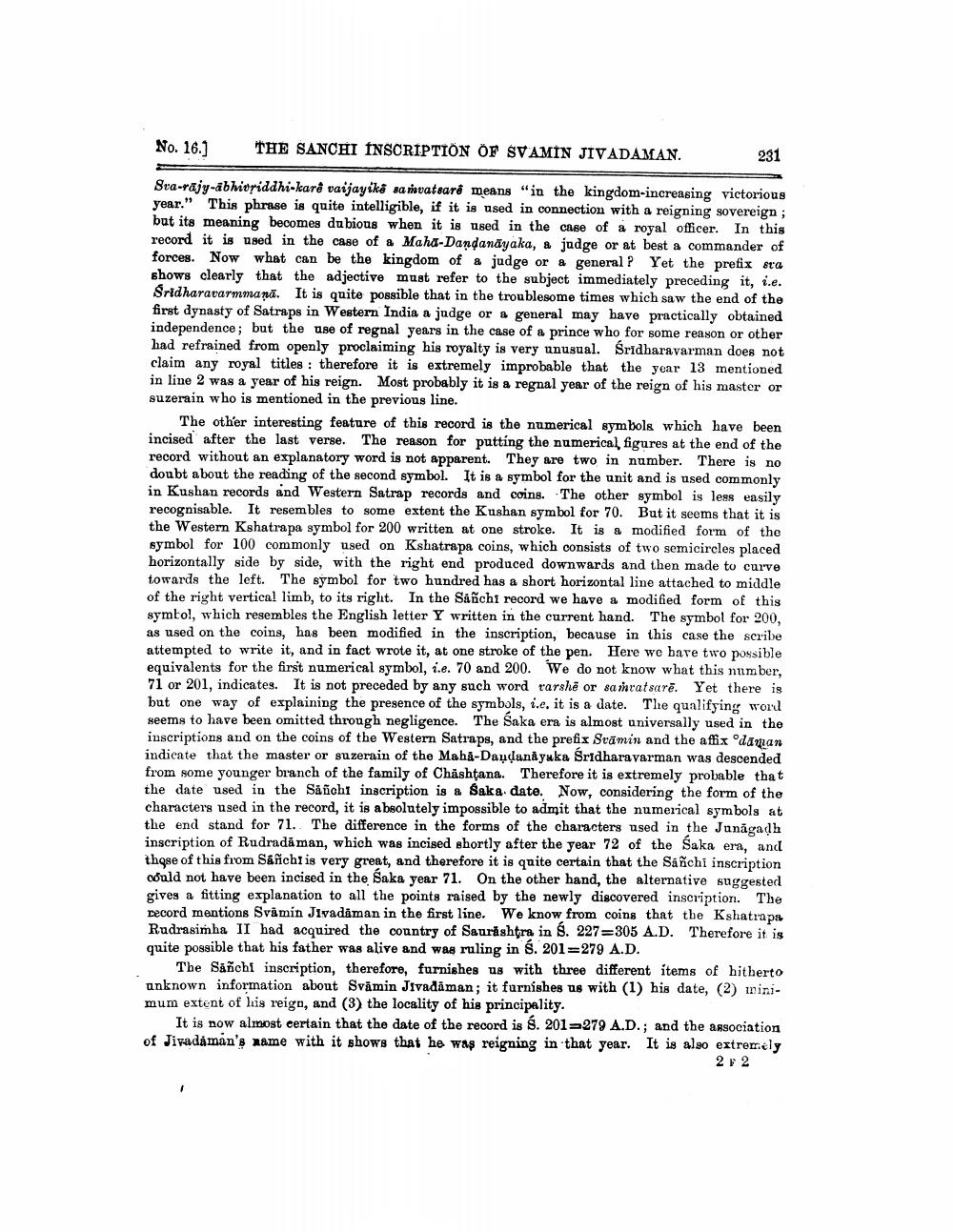________________
THE SANCHI INSCRIPTION OF SVAMIN JIVADAMAN.
231
Sva-rajy-abhivriddhi-karê vaijayikê samvatsare means "in the kingdom-increasing victorious year." This phrase is quite intelligible, if it is used in connection with a reigning sovereign; but its meaning becomes dubious when it is used in the case of a royal officer. In this record it is used in the case of a Maha-Dandanayaka, a judge or at best a commander of forces. Now what can be the kingdom of a judge or a general? Yet the prefix sta shows clearly that the adjective must refer to the subject immediately preceding it, i.e. Sridharavarmmana. It is quite possible that in the troublesome times which saw the end of the first dynasty of Satraps in Western India a judge or a general may have practically obtained independence; but the use of regnal years in the case of a prince who for some reason or other had refrained from openly proclaiming his royalty is very unusual. Śridharavarman does not claim any royal titles: therefore it is extremely improbable that the year 13 mentioned in line 2 was a year of his reign. Most probably it is a regnal year of the reign of his master or suzerain who is mentioned in the previous line.
No. 16.1
The other interesting feature of this record is the numerical symbols which have been incised after the last verse. The reason for putting the numerical, figures at the end of the record without an explanatory word is not apparent. They are two in number. There is no doubt about the reading of the second symbol. It is a symbol for the unit and is used commonly in Kushan records and Western Satrap records and coins. The other symbol is less easily recognisable. It resembles to some extent the Kushan symbol for 70. But it seems that it is the Western Kshatrapa symbol for 200 written at one stroke. It is a modified form of the symbol for 100 commonly used on Kshatrapa coins, which consists of two semicircles placed horizontally side by side, with the right end produced downwards and then made to curve towards the left. The symbol for two hundred has a short horizontal line attached to middle of the right vertical limb, to its right. In the Sañchi record we have a modified form of this symbol, which resembles the English letter Y written in the current hand. The symbol for 200, as used on the coins, has been modified in the inscription, because in this case the scribe attempted to write it, and in fact wrote it, at one stroke of the pen. Here we have two possible equivalents for the first numerical symbol, i.e. 70 and 200. We do not know what this number, 71 or 201, indicates. It is not preceded by any such word varshe or samratsare. Yet there is but one way of explaining the presence of the symbols, i.e. it is a date. The qualifying word seems to have been omitted through negligence. The Saka era is almost universally used in the inscriptions and on the coins of the Western Satraps, and the prefix Svamin and the affix °daman indicate that the master or suzerain of the Maha-Daudanayaka Sridharavarman was descended from some younger branch of the family of Chashtana. Therefore it is extremely probable that the date used in the Sañcht inscription is a Saka date. Now, considering the form of the characters used in the record, it is absolutely impossible to admit that the numerical symbols at the end stand for 71. The difference in the forms of the characters used in the Junagadh inscription of Rudrada man, which was incised shortly after the year 72 of the Saka era, and those of this from Sáñicht is very great, and therefore it is quite certain that the Sanchi inscription could not have been incised in the Saka year 71. On the other hand, the alternative suggested gives a fitting explanation to all the points raised by the newly discovered inscription. The record mentions Svamin Jivadaman in the first line. We know from coins that the Kshatrapa Rudrasimha II had acquired the country of Saurashtra in §. 227-305 A.D. Therefore it is quite possible that his father was alive and was ruling in S. 201-279 A.D.
The Sanchi inscription, therefore, furnishes us with three different items of hitherto unknown information about Svamin Jivadaman; it furnishes us with (1) his date, (2) minimum extent of his reign, and (3) the locality of his principality.
It is now almost certain that the date of the record is §. 201-279 A.D.; and the association of Jivadaman's name with it shows that he was reigning in that year. It is also extremely
22




